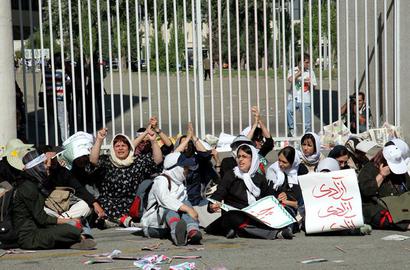Iran made history on October 10 when female football fans were allowed to into Azadi Stadium to watch the national team play Cambodia — prompting widespread celebrations and debate.
“Await the morning of your fortune to rise, for this was only the gift of dawn,” people posted on social media, alongside photographs of Sahar (“Dawn”) Khodayari, the woman who set herself on fire in September in protest against the stadium ban on women and her treatment by authorities. She died a few days later. The verse comes from a famous poem by the 12th-century Persian poet Anvari, and was posted to commemorate Khodayari, also known as the “Blue Girl,” and her desperate plea that ended in death, as well all the women who have been denied their right to enter stadiums over the last 40 years, and who have faced physical violence and jail terms for demanding this right.
But the victory on October 10, when the Iranian Football Federation opened the doors of Azadi stadium to women for the first time — and not just for a select, handpicked group — was not a perfect end to the years of discrimination. Women were allowed in, but a vast number of seats in the stadium remained empty, with many women stranded outside and denied tickets. As people posting on social media remarked, there is still some way to go before women get their “half-share of azadi (‘Freedom’).”
The “White Scarves”
The first time after the Islamic Revolution of 1979 that women entered Azadi Stadium was in 1997 — though it wasn’t planned and there wasn’t a game to watch. Iran had played against Australia in Melbourne and qualified for the 1998 FIFA World Cup in France. To prevent overcrowding at the airport, the interior ministry decided to helicopter the national football team into Azadi Stadium for the fans to welcome them. At the stadium, men and women stood side by side on the stands and cheered for their victorious footballers.
It was at this time when women started demanding their right to enter stadiums and watch football, but it took another eight years before the calls crystalized into public action, in 2005 when Iran played Bahrain. Women wore white headscarves with the inscription “Women’s share, half of Azadi” written on them, and sat in rows on the grass, facing the western gate of Azadi Stadium. It was more than 20 years after the revolution and these women, representatives of half of the population, sought to reclaim what they had lost after the revolution, including the right to go to stadiums and watch football.
Authorities dismissed the calls, and said that football was for men, and only men should go to games. The eight-year bloody war with Iraq from 1980 to 1988, followed by the huge undertaking to rebuild the shattered country and economy, meant for many years there was very little energy or motivation to resume the fight for women to enter stadiums to watch matches. But as time passed, things changed. The presidential election of 1997 and the victory of reformist candidate Mohammad Khatami led to some relaxation of the tight restraints on personal liberties, giving hope to women who were looking for their “share of freedom.”
The journalist, poet and women’s rights activist Asieh Amini has been a “white scarves” protester since that time. “In 2005, important developments occurred in the arena of women’s rights,” she says. “Different groups of women with a wide spectrum of beliefs and goals had gathered together. Numerous topics about women were discussed and all kinds of suggestions were made. One of the issues that emerged from these sessions was the issue of going to stadiums.”
Earlier, we had discussed the right for women to go to stadiums and watch games as a right that they had been robbed of. Younger women wanted it. We issued at least two statements that focused on this subject. We asked that if the law does not ban women from entering stadiums, then why do they not allow them into stadiums? But on that specific day, the day that Iran and Bahrain had a game, we collectively decided that we would take action ourselves. We announced that we were going to the stadium and reminded the authorities that they were responsible for keeping us safe.”
Amini says it was a peaceful civil action. “Some suggested that we should wear white headscarves as a sign of peace and friendship. We all tied pieces of red cloth to our ankles to signal that we were protesting the ban on entering stadiums. Another group suggested the beautiful and eloquent slogan of ‘Women’s share, half of Azadi.’ One of us said ‘let’s take a small TV with us and if they won’t allow us in, we can watch the game right outside the stadium on TV. This by itself will clearly demonstrate the violation of the rights of half the society.’”
More than 20 women put on white scarves and set out for Azadi Stadium. “We said that we would go and sit right in front of the gate and if they opened it, we would go in,” Amini remembers. “Before we got there, our reporter friends sent a message saying, ‘they are waiting for you here.’ And you can see in the pictures a line of anti-riot police who were stationed there.”
“Others and I who had gathered in front of Azadi Stadium in those days are happy today not just because the small share of seats that were granted to women [on October 10 for the Iran-Cambodia game] is a very great achievement,” she says. “We are happy because our struggle and our efforts have borne fruit. That movement of ‘White Scarves’ was taken up and was continued by others. That movement found a life of its own and became an influential event in the history of the fight to claim women’s rights.”
The “Freedom Women”
A few years later, a new phase of the movement emerged, led by women who became known as “Bearded Girls” and then “Freedom Women.” When Persepolis football team played, these women would disguise themselves as young men, wearing fake beards or moustaches, and try to enter the stadium. Sometimes they managed to sneak in and sometimes they were discovered, in which case they were either prevented from entering or loaded into a van and taken to the police station and told to pledge that they would not do it again.
One of them was Zahra Khoshnavaz, a poet, writer and football fan who repeatedly took the risk of disguising herself to enter the stadium. Every time she succeeded in getting into the stadium she posted a photograph of herself on Instagram a few hours after the game. She and others like her enjoyed their time when they got into the stadium, but what “Freedom Women” really wanted was to enter the stadium as themselves, not disguised as men.
At last the international football federation (FIFA) heard their outcry and ordered Iran to respect women’s rights and open the doors of stadiums to them. Iranian authorities retreated a little, but still did whatever they could to fool FIFA and make it think they were following the governing body’s regulations, even though they were doing their best to ignore them.
On October 16, 2018, a contingent of 150 women was allowed into Azadi Stadium to watch a friendly match between Iran and Bolivia. But the female fans allowed in were not members of the general public who had bought tickets to watch the game. Iran’s football federation had handpicked them in an effort to stop the international football federation criticizing Iran’s illegal ban on women spectators. So Khoshnavaz, like many other women who had arrived at the stadium in the vain hope of getting in, was kept outside even though, as photographs show, many seats located in the area reserved for women were left empty.
“Of course I don’t want to disguise myself as a man,” Zahra Khoshnavaz told IranWire. “The day that the national team competed against Bolivia we learned that they were going to give some of the seats to women, so I went to Azadi Stadium in a dress, like I do every day.” But she was not allowed entry.
“I found it painful,” Khoshnavaz said. “It used to be that they only discriminated against women, but on the day of the Iran-Bolivia game I witnessed a greater insult and humiliation. They discriminated against me and in favor of the handpicked women who went into the stadium. This motivated me to again open the gates of the stadium for myself.”
The “Blue Girl”
Sahar Khodayari set herself on fire on Tehran’s Shariati Avenue on September 2, 2019. At the time, nobody knew her name and nobody had seen her face. All that was known was that she was a fan of Tehran football team Esteghlal. Her crime was trying to enter a stadium to watch her team play. But police prevented her from entering the stadium, and when she resisted they arrested her and sent her to jail, where she spent three days.
Her sister said the judge had sent Sahar Khodayari to Varamin Prison, where the conditions aggravated her frail mental state. “My sister lived in terror until she was released on bail,” she said. “But when she went to the courthouse to get back her mobile phone, by chance she heard that she had been sentenced to six months in prison. With her aggravated and difficult mental condition, she set herself on fire.” She died a few days later in hospital. It was only after her death that Sahar Khodayari’s name became known to the public.
Her tragic death led to an international outcry, prompting FIFA to step up its pressure on the Iranian Football Federation to open the doors of the stadium to all Iranian women, and not only a handpicked group. The federation complied on October 10, albeit in an imperfect manner. Women were able to watch the game without having to disguise themselves as men. But, sadly, the “Blue Girl” could not be one of them.
It has been 15 years since Iranian women started this movement and their fight against gender inequality and misogynic laws and to reclaim the most basic of human rights. The White Scarves, the Freedom Women and the Blue Girl all deserve their place in Iranian history. They are all Iranian women the world should know.
Related Coverage:
Government Tries to Hijack Victory for Women in Stadiums, October 11, 2019
Women in Azadi Stadium After Long Ban, October 10, 2019
Historic Moment for Iran as Women Allowed into Stadium to Watch Football, October 10, 2019
Iran’s Ban on Female Journalists Entering Stadiums, October 9, 2019
International Football Federation Scrutinizes Iran’s Ticket Quotas for Women, October 7, 2019
Iran: Stadium Seating Cap Endangers Women, October 5, 2019
The World Reacts to the Tragic Death of the “Blue Girl”, September 26, 2019
FIFA Ultimatum to Iran: Let Women in Stadiums, September 23, 2019
FIFA Responds to IranWire about the Death of the “Blue Girl”, September 10, 2019
Woman Who Set Herself on Fire Dies, September 9, 2019
Iran Attempts to Fool FIFA, August 27, 2019
Decoding Iran’s Politics: Football and State Interference, June 11, 2019
visit the accountability section
In this section of Iran Wire, you can contact the officials and launch your campaign for various problems


























comments